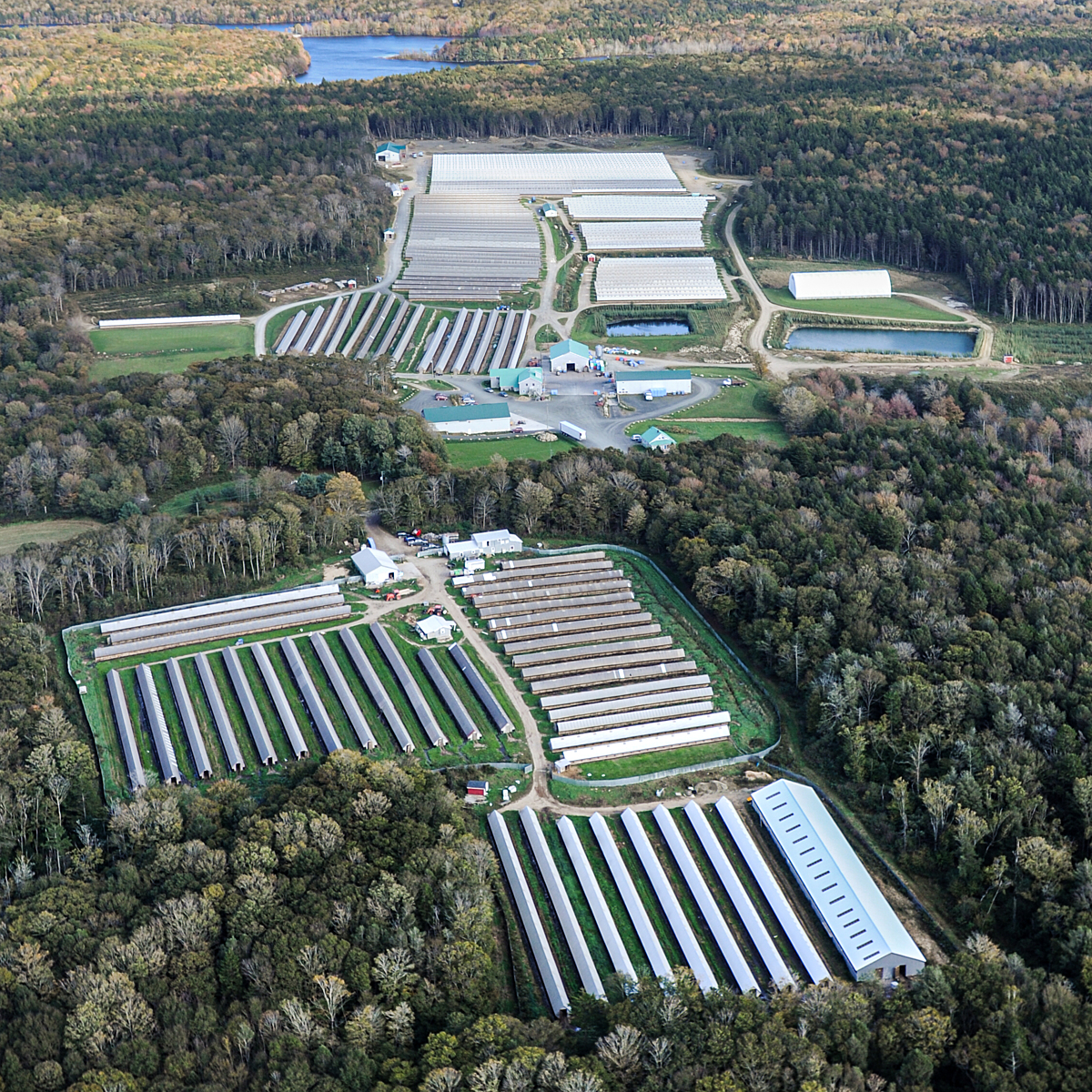A turkey who escaped being smothered by firefighting foam sits on top of the bodies of dead birds from their flock. Israel, 2016.
Glass Walls / We Animals
[Content warning: Contains confronting images and/or video footage]
Over the last twenty years, we—an animal photojournalist (Jo-Anne McArthur) and a human rights and global public health physician (Hope Ferdowsian)—have witnessed at very close range the lives of animals and the confined, unsanitary conditions in which humans keep them. We’ve visited, written about, and documented places of industrial animal use so that we can publish evidence of the inherent and rampant cruelty of modern farming. Collectively, this work has taken us to six continents, and we continue relentlessly so that we can contribute to the clarion call to reduce and ultimately end the suffering humans impose on billions to trillions of animals each year.
Edited by: Kimberly J. Soenen
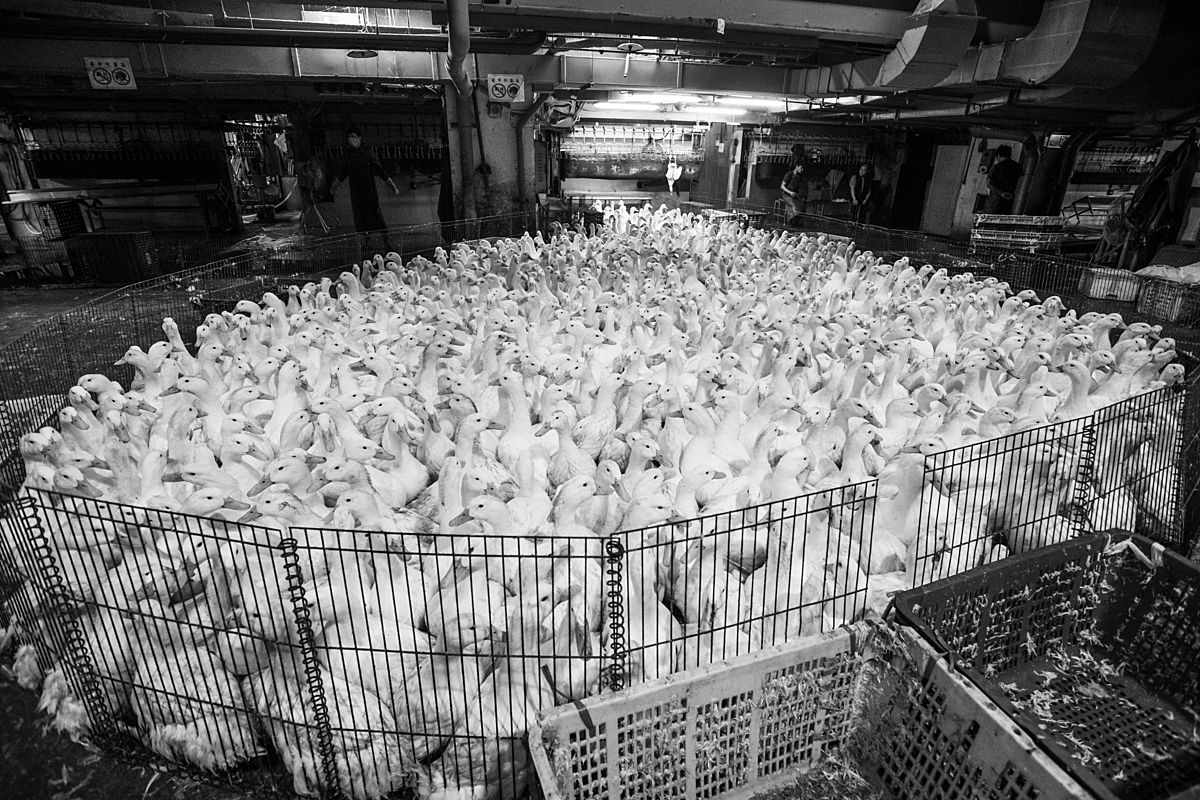
Ducks penned for slaughter. Taipei, Taiwan, 2019.
Jo-Anne McArthur / We Animals
As an animal photojournalist, Jo-Anne began scaling farm fences 20 years ago to document what people do to animals inside factory farms, including family separation, dehydration and starvation, and blunt force trauma. As a child, Hope watched from a window the sheep she loved being killed in the presence of their families, as they and she cried out for it to stop—memories that would later fuel her medical career dedicated to ending human and animal suffering.
Though we both struggle daily with these images, we believe it is critically important for others to see what we have seen. But Big Ag does not want us to see the reality of what transpires on factory farms, since the industry’s leaders know that real discourse about animal farming will hurt their harm-for-profit bottom line. But you can choose to see.

After being drenched with firefighting foam, a turkey tips back their head as they slowly die atop the dead bodies of their flockmates. Following the detection of avian influenza in the turkey flock at this Israeli kibbutz, authorities used compressed firefighting foam to mass-suffocate the birds, claiming it to be the most efficient and humane method of extermination. Numerous birds slowly died or remained in various degrees of consciousness after the foam’s application. Israel, 2016.
Glass Walls / We Animals
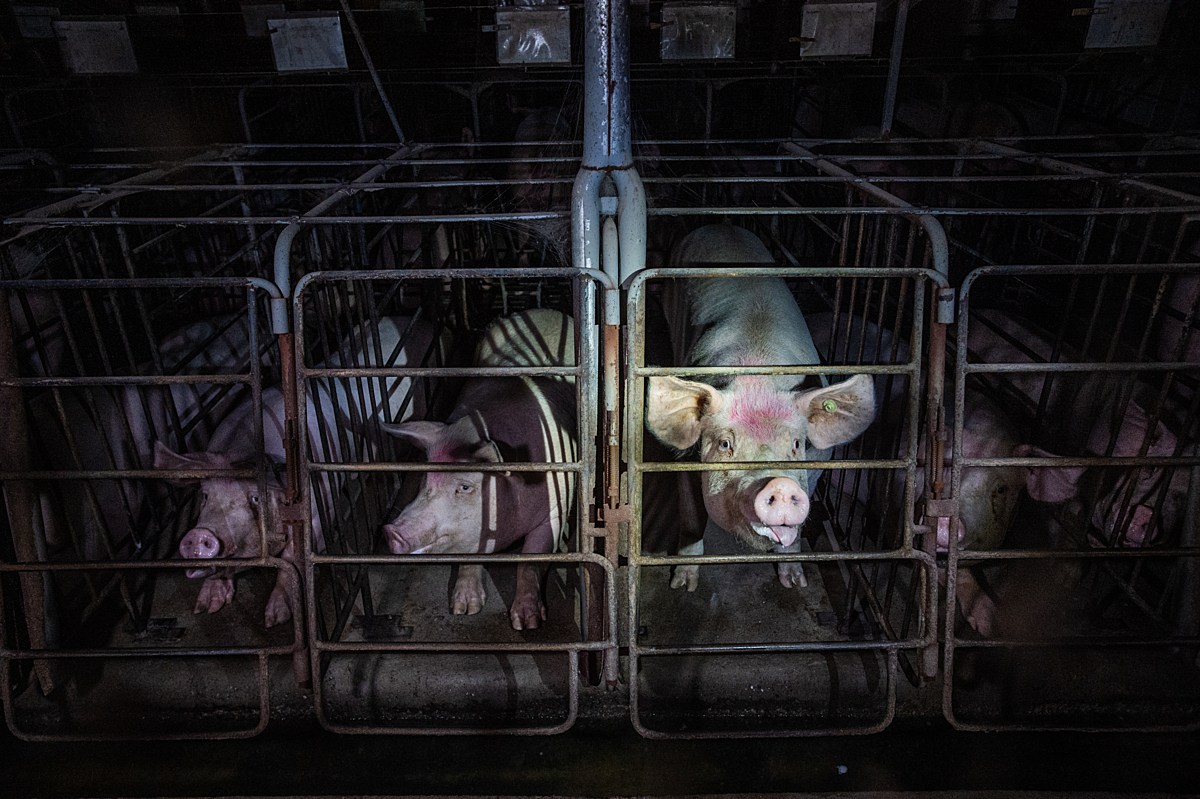
Sows peer out from gestation crates at an industrial pig farm. These sows live confined inside bare, concrete-floored enclosures that are large enough only for the sows to sit, stand and lie down, but they cannot walk or turn around. Quebec, Canada, 2022.
Jo-Anne McArthur / We Animals
As a society, we keep trying to outrun and ignore the risks created by the exploitation of animals, despite the scientific, medical, and journalistic evidence that we and many others have presented over recent decades. Viruses are emerging in exponential ways, animals are suffering in greater numbers, people are getting sicker, and our environment is weeping with animal waste, agrochemicals, and pathogens that are resistant to antimicrobials. There are no true winners here.
The United States will breed, cage, and kill an estimated nine billion chickens in factory farms this year. In Europe, billions more are killed, and in Canada, an estimated 800 million are killed. These horrifying statistics are increasingly reflected across Africa, Asia, and South America. Globally, billions of chickens are made genetically similar by design, routinely and systematically packed together tightly, and deprived of natural lives. And the farms that are home to these individuals serve as a figurative petri dish for infectious diseases.
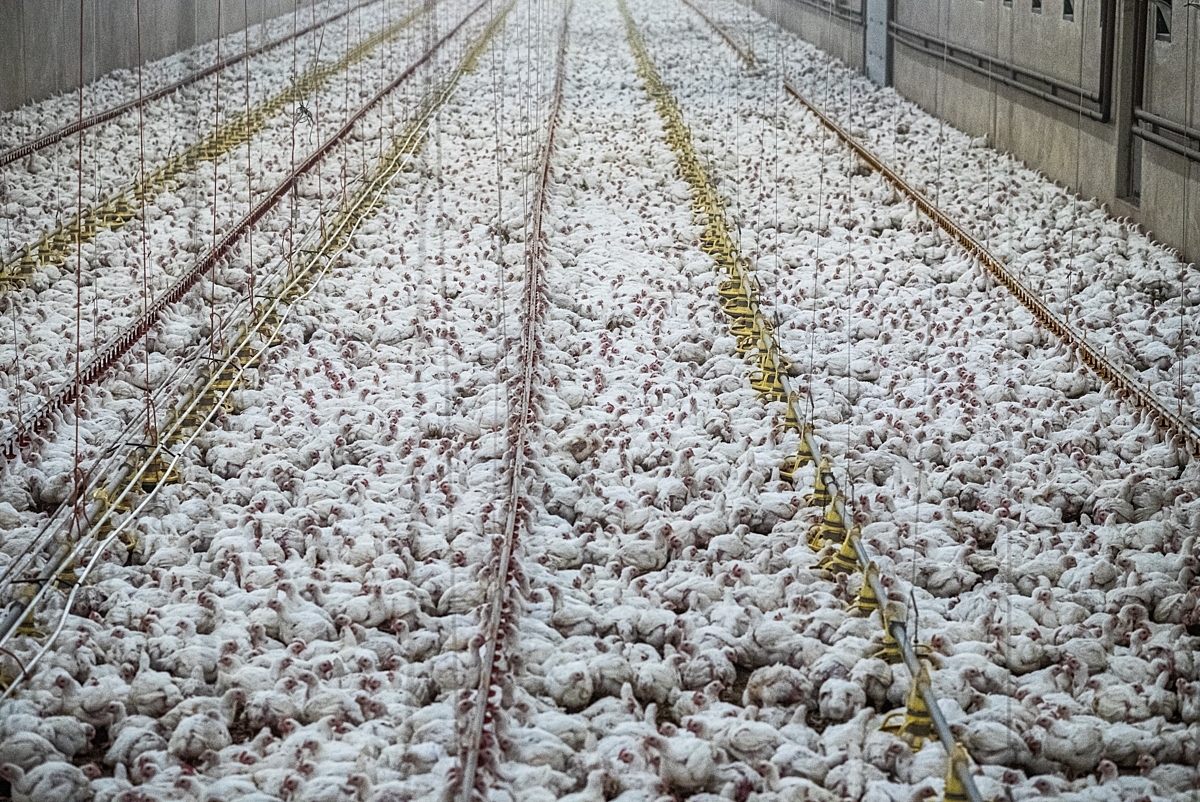
As far as the eye can see. Thousands of chickens packed into a broiler hall complex. Finland, 2017.
Juho Kerola / HIDDEN / We Animals
The H5N1 bird flu, also known as avian influenza, is a highly pathogenic virus and is driven by factory farms globally. According to the Centers for Disease Control and Prevention, from January 2022 to April 2024, 48 US states have had outbreaks, and over 82 million chickens and turkeys have either died from bird flu or been killed to prevent its spread. In 2023, the US Department of Agriculture paid out over half a billion dollars to poultry producers who culled their flocks due to bird flu outbreaks on their farms. And just recently, the New York Times reported that the virus has now jumped to cows used in dairy production. As of April 1, 2024, two states had reported human cases of highly pathogenic avian influenza A.
Tractors dump loads of dead turkeys into a truck during a disposal operation at a farm with an avian influenza (H5N1) outbreak. Feathers blow away in the wind, posing a possible biosecurity risk to wild bird populations or other poultry farms nearby. United Kingdom, 2022.
Ed Shephard / Generation Vegan / We Animals
Two hens who survived the ventilation shut-down huddle together in a small battery cage at a factory farm in Iowa. They are lethargic and missing most of their feathers. USA, 2022.
Direct Action Everywhere / We Animals
Scientists are particularly concerned about avian influenza since a deadly bird flu pandemic could quickly spread around the globe within months. Researchers have already documented the virus’s resistance to some medicines used to treat influenza.
Almost every animal you can imagine is kept for human use, increasing the risk for emerging and re-emerging infectious diseases. Between 60 and 75 percent of emerging infectious diseases are zoonotic in origin, and each year, zoonoses cause more than 2.5 million human deaths worldwide.
During a mass cull of over 264,000 chickens on an Italian chicken farm affected by avian influenza, a loader dumps a bucketful of live chickens into a large bin to be killed by gassing. The birds flap and struggle as they are piled atop one another, and workers pick up stray individuals from the ground and roughly throw them into the bin. It takes approximately 30 minutes to fill the bin with live chickens before it is closed and the gas is administered. During this time, the weight of the birds piled on top of them slowly crushes the live birds dropped into the bottom of the bin. Workers stand on a truck with gas cylinders parked beside a closed gassing bin. Vicenza, Italy, 2022.
Essere Animali / We Animals
The global transition toward increased meat, egg, and dairy production—and intensification—is not only fueling infectious, communicable diseases. It also fuels chronic, noncommunicable diseases such as heart disease and cancer—the two biggest killers of Americans. Nonetheless, the US government spends tens of billions of dollars each year to subsidize Big Ag, driving down the cost of a chicken sandwich to a fraction of its true cost while driving up related healthcare costs.
Meatpacking companies are also among the most dangerous industries, posing risks to workers that range from the loss of limbs to posttraumatic stress disorder. Slaughterhouses are violent and filthy. Cattle, sheep, and birds are often hung by a leg and bled out as they kick and struggle to survive. Workers absorb the visible and invisible trauma of being in the presence of such cruelty. And communities suffer, as well. In 2009, sociologist Amy Fitzgerald and her colleagues published an eight-year analysis of 581 US counties, which found that slaughterhouse location, compared with the location of other industries, is associated with increases in total arrest rates, arrests for violent crimes, and arrests for rape and other sexual offenses.

A dead pig lays in the aisle between rows of pig enclosures at an industrial pig farm. Animals who are sick or weak are often removed from the pens and left in the aisle with no food, water, or veterinary care until they die. Chile, 2012.
Gabriela Penela / We Animals
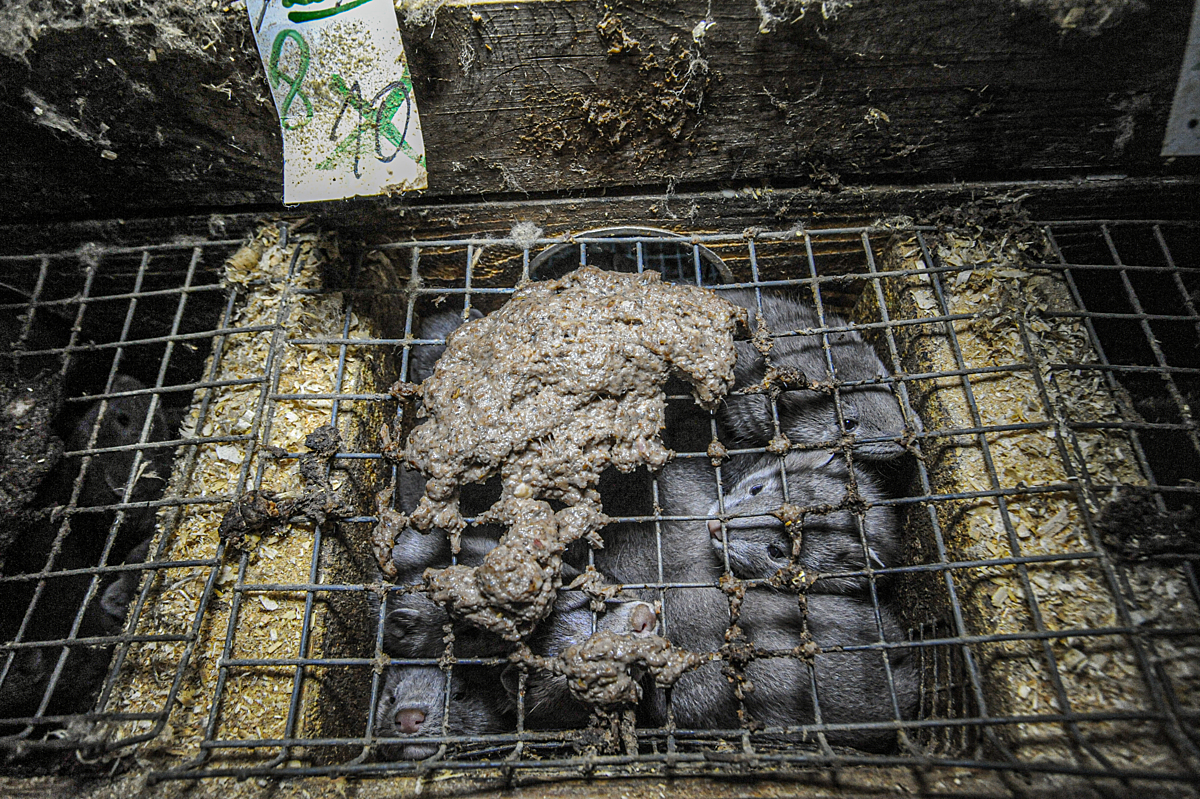
Ten, now eight, mink kits in a nesting box. Sweden, 2010.
Jo-Anne McArthur / Djurrattsalliansen / We Animals
Where do these dead farmed animals and their waste go once killed, incinerated, or buried? Into our aquifers, air, soil, and food. Meanwhile, animal farming is also responsible for at least 14.5 percent of all greenhouse gas emissions and 80 percent of deforestation. We need look no further than the daily floods, fires, and droughts to underscore how Big Ag impacts the health of the environment. And marginalized communities invaded by Big Ag bear the brunt of water, soil, and air pollution associated with factory farms.
Aerial view of a fur farm. Nova Scotia, Canada, 2014.
Jo-Anne McArthur / #MakeFurHistory / We Animals
So, What Can You Do?
First, see the reality of what is happening and demand transparency. Oppose Ag-gag legislation in nations such as the US, Canada, and Australia. Ag-gag laws prohibit journalistic documentation of what happens inside factory farms.
Next, support legislative reforms in other areas—such as the Farm Bill, a package of US legislation passed roughly every five years that has a tremendous impact on which types of farming are subsidized, what foods are produced, and how animals and people suffer or thrive as a result of our farm and food systems.
Choose a plant-based diet—for you and the animals. Plant-based diets reduce the risk of heart disease, cancer, and infectious diseases, and a plant-based diet produces roughly half the greenhouse gas emissions of a meat-based diet.
Elect leaders who care about these connections.
Finally, spread the word. The health and well-being of people, animals, and the planet are counting on it.

















Explore and download more visuals like these from We Animals’ documentation of the global food system.



